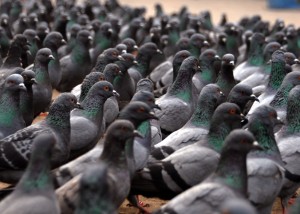 A memorable scene from the movie Fight Club displays the ultimate revenge against luxury car owners. Edward Norton and Brad Pitt lay down massive amounts of bird feed on the roofs of luxury car dealerships resulting in the absolute covering of the cars in bird droppings. The scene, a point of humour in the movie, is far from it in real life.
A memorable scene from the movie Fight Club displays the ultimate revenge against luxury car owners. Edward Norton and Brad Pitt lay down massive amounts of bird feed on the roofs of luxury car dealerships resulting in the absolute covering of the cars in bird droppings. The scene, a point of humour in the movie, is far from it in real life.
Pigeons and other birds have adapted so well to the urban environment. Our litter provides a constant food source and our buildings are perfect for roosting, and there are barely any predators. Because of this you can find them practically everywhere. These airborne pests make their homes in rafters, under bridges, parking garages, airport hangars, warehouses, lube shops, repair facilities and more. In any environment, these nuisance birds can cause problems but in concentrated populations can bring serious risk.
Pigeons are the most common pest and are well adapted to urban life and widely distributed. They breed throughout the year, producing up to six broods annually. Gulls have adapted so well to city life they are found far inland away from their coastal origins and can be aggressive when nesting. Bird droppings can carry disease, erode steel, and devalue other capital assets.
More than a nuisance
Wherever birds nest or roost on buildings, fouling is an inevitable result. Apart from being unsightly, accumulations of bird droppings can lead to long term property problems. Bird waste contains uric acid, and has also been identified by inspectors as a contributing factor in the tragic bridge collapse of 2007 in Minneapolis.
Bird droppings can deteriorate almost any building material. It can block gutters leading to water ingress and cause localized flooding, damage can also build up unseen on flat roof spaces. Masonry, particularly limestone is highly sensitive to bird droppings. Ornate architecture provides more spaces for birds to roost leading to disfigurement of a buildings design features. Bird droppings can ruin fabric awnings and short out electrical equipment. Inevitably maintenance activity has to increase to protect a building against bird infestation.
Health Risks
The real danger is to your health, as bird droppings contain hazardous diseases and parasites. Entomologist research has identified more than 60 transmittable diseases and dangerous parasitic organisms associated with bird droppings, Ornithosis (a flu type disease) Histoplasmosis & Cryptococcosis (a potentially fatal lung infection), Ecoli (a gastro-enteritis disease), and Toxoplasmosis (a parasitic infection) are among the most common, as well as Encephalitis and Meningitis.
The most common methods of contracting illness from droppings are inhalation and ingestion. Inhalation occurs when droppings are dried and disturbed creating an airborne dust that can be inhaled. Histoplasmosis can be transmitted through inhalation. Ingestion occurs when eating or drinking foods that have come into contact with bird related micro-organisms. Toxoplasmosis can be transmitted by ingestion. In addition to disease and related illnesses, bird droppings also create a slip hazard a particular problem with fire escapes.
Taking control
There are many solutions in the market available to fight back against your avian invasion ranging from lethal to non-lethal. Nets, wires, spikes, gels, visual deterrents, sonic devices, live trappings, falconry, and other population control measures have been used to manage offending bird problems.
You may choose to use two or more solutions together as part of an aggressive control strategy, but remember birds are adaptive, make a note to move visual deterrents or change settings on machines to keep birds off balance.